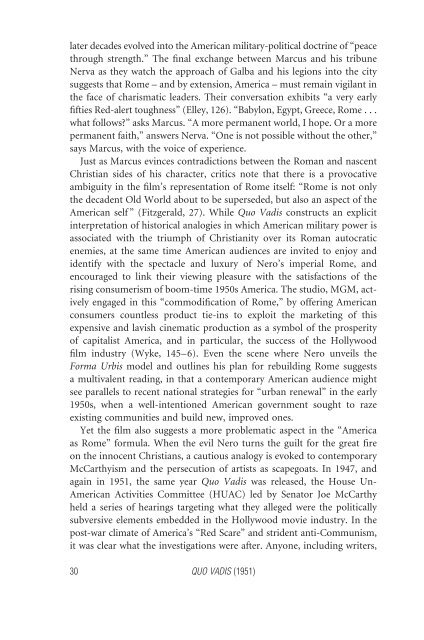Big Screen Rome - Amazon Web Services
Big Screen Rome - Amazon Web Services
Big Screen Rome - Amazon Web Services
Create successful ePaper yourself
Turn your PDF publications into a flip-book with our unique Google optimized e-Paper software.
later decades evolved into the American military-political doctrine of “peace<br />
through strength.” The final exchange between Marcus and his tribune<br />
Nerva as they watch the approach of Galba and his legions into the city<br />
suggests that <strong>Rome</strong> – and by extension, America – must remain vigilant in<br />
the face of charismatic leaders. Their conversation exhibits “a very early<br />
fifties Red-alert toughness” (Elley, 126). “Babylon, Egypt, Greece, <strong>Rome</strong> . . .<br />
what follows?” asks Marcus. “A more permanent world, I hope. Or a more<br />
permanent faith,” answers Nerva. “One is not possible without the other,”<br />
says Marcus, with the voice of experience.<br />
Just as Marcus evinces contradictions between the Roman and nascent<br />
Christian sides of his character, critics note that there is a provocative<br />
ambiguity in the film’s representation of <strong>Rome</strong> itself: “<strong>Rome</strong> is not only<br />
the decadent Old World about to be superseded, but also an aspect of the<br />
American self ” (Fitzgerald, 27). While Quo Vadis constructs an explicit<br />
interpretation of historical analogies in which American military power is<br />
associated with the triumph of Christianity over its Roman autocratic<br />
enemies, at the same time American audiences are invited to enjoy and<br />
identify with the spectacle and luxury of Nero’s imperial <strong>Rome</strong>, and<br />
encouraged to link their viewing pleasure with the satisfactions of the<br />
rising consumerism of boom-time 1950s America. The studio, MGM, actively<br />
engaged in this “commodification of <strong>Rome</strong>,” by offering American<br />
consumers countless product tie-ins to exploit the marketing of this<br />
expensive and lavish cinematic production as a symbol of the prosperity<br />
of capitalist America, and in particular, the success of the Hollywood<br />
film industry (Wyke, 145–6). Even the scene where Nero unveils the<br />
Forma Urbis model and outlines his plan for rebuilding <strong>Rome</strong> suggests<br />
a multivalent reading, in that a contemporary American audience might<br />
see parallels to recent national strategies for “urban renewal” in the early<br />
1950s, when a well-intentioned American government sought to raze<br />
existing communities and build new, improved ones.<br />
Yet the film also suggests a more problematic aspect in the “America<br />
as <strong>Rome</strong>” formula. When the evil Nero turns the guilt for the great fire<br />
on the innocent Christians, a cautious analogy is evoked to contemporary<br />
McCarthyism and the persecution of artists as scapegoats. In 1947, and<br />
again in 1951, the same year Quo Vadis was released, the House Un-<br />
American Activities Committee (HUAC) led by Senator Joe McCarthy<br />
held a series of hearings targeting what they alleged were the politically<br />
subversive elements embedded in the Hollywood movie industry. In the<br />
post-war climate of America’s “Red Scare” and strident anti-Communism,<br />
it was clear what the investigations were after. Anyone, including writers,<br />
30 QUO VADIS (1951)



